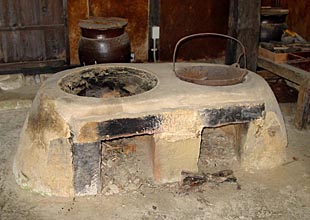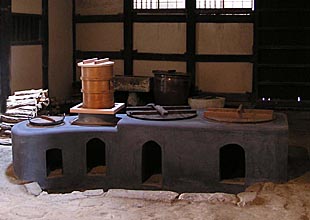|
||
 |
||
1 A cooking range. It was constructed primarily of earth or clay, nendo 粘土; although stone, tile, and brick were also used from the mid. 19c. Fuel was inserted through stokeholes *takiguchi 焚口, in the side, and a fire was made in the hollow interior. Pans, nabe 鍋, and cauldrons kama 釜 or 竈, of bronze, iron or pottery were set into the circular hole or holes kamaguchi 竈口, for cooking. The cauldron or pan had a projecting flange or rim, nabewa 鍋輪, which rested on the edge of the cooking hole to allow its lower part to project into the fire below. Along with the open hearth *irori 囲炉裏, the kamado was one of the two basic forms of domestic cooking appliance in use in pre-modern Japan and it was also adapted for certain proto-industrial processes, such as salt manufacture. Kamado were used throughout Japan although design varied according to location and period. The kamado is believed to have been introduced to Japan during the Kofun period, since the earliest known examples were revealed by excavation of Kofun period pit dwellings *tateana juukyo 竪穴住居. They were made of clay and earth, located close to the periphery of the pit, and a clay chimney was often incorporated to vent smoke, an arrangement reminiscent of early kilns, though on a smaller scale. Such kamado were built-in, but portable kamado of pottery hajiki 土師器, were also in use in the ancient period. The late 12c Mount Shigi Legend Picture Scroll Shigisan engi emaki 信貴山縁起絵巻 shows a large non-portable single-hole kamado set directly upon the earth in use by the end of the Heian period. By contrast, an illustration of a contemporary Buddhist monk's residence in the mid 14c picture scroll Boki ekotoba 慕帰絵詞 (roll 8), shows a 2-hole kamado set upon a freestanding timber framed platform with a plastered base. By the Edo period in the kitchens *daidokoro 台所, of upper class residences and in temple kitchens *kuri 庫裡, large kamado with multiple cooking holes were used. They were most often situated in the earthfloored area *doma 土間: sometimes they were freestanding and sometimes adjoining the raised timber floor. In the latter case, the stokehole usually faced toward the doma, and a plastered wall was sometimes built above it, as in the Kuri of Shuuon'an 酬恩庵 (near Kyoto), to screen the food preparation area from smoke. In vernacular houses *minka 民家, kamado tended to develop during the course of the Edo period from a low simple design to elaborate multiple-cauldron ranges high enough to tend while standing rather than squatting. Even in the Kinki 近畿 region, where the design of kamado was most advanced and the open hearth little used, archaeological investigations undertaken in the doma of important cultural properties juuyoubunkazai 重要文化財, in Imaichou 今井町, Nara, have revealed that the kamado of urban vernacular houses *machiya 町家, in the 17c were low, often set in a shallow sump excavated in the doma, and had only one cooking hole. By the late Edo period, larger minka of the Kinki region had large ranges with polished black tops, a base, and a stokehole faced with tile. The most impressive such kamado, known as magatamagata kamado 勾玉形竈 (comma-jewel shaped cooking range) had a curved or horseshoe plan with as many as eleven cooking holes. In remote areas of Hokuriku 北陸 or Touhoku 東北 regions, the irori was more important and the kamado relatively undeveloped. In such districts, even in larger houses, kamado remained low and rustic in construction and two cooking holes or more were rare. By the late Edo period, some households had a variety of kamado: kamado for use in a raised floor space rather than the doma; small portable kamado (this was also the commonest type in cramped urban tenements or *nagaya 長屋); a large one for preparing fodder for domestic animals; and often a special one for use only on festive occasions and for preparing rice cakes mochi 餅. The symbolic significance of the kamado was in proportion to its functional importance as a cooking appliance and adjunct of the hearth. Its tutelary spirit *kamadogami 竈神, was one of the principal household deities, revered as provider of the means to cook and feared as a potential cause of conflagration.
 Old
Honda 本田 house (Nagasaki) |
 Nagatomi
永富 house (Hyougo) |
2 In parts of Niigata prefecture, the central part of an open hearth *irori 囲炉裏, where the fire is warmest, over which cauldron or pan is suspended for cooking purposes.
By contrast,peripheral ash-filled zone of the hearth is termed irori or irobuchi 囲炉縁.
3 Irori in minka on the island of Hachijoujima 八丈島.
4 In minka in certain areas, a term for the kitchen: eg.in Miyazaki prefecture, a freestanding structure which functioned as a kitchen betsumune-no-suijiya 別棟の炊事屋.
5 In the Edo period, a general term mentioned in contemporary documents for a household: thus kamado sanbyaku gojuuyon ken 竈三百五十四軒 means three hundred and fifty four households.
6 In parts of Aomori and Iwate prefectures, term for a branch house, bunke 分家.
(C)2001 Japanese Architecture and Art Net Users System. No reproduction or republication without written permission.
掲載のテキスト・写真・イラストなど、全てのコンテンツの無断複製・転載を禁じます。

